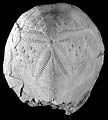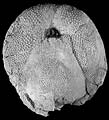The Echinoid Directory
Melitia Fourtau, 1913, p. 68
| Diagnostic Features |
|
|---|---|
| Distribution | The type species is from the Lower Miocene of Malta. |
| Name gender | neuter |
| Type | Metalia melitensis Gregory, 1891, p. 621, by original designation. |
| Classification and/or Status |
|
| Remarks | Created by Fourtau (1913) to encompass forms with a radiating pattern of tubercles in the subanal fasciole. In fact, as pointed out by Lambert & Thiery (1921), this is a common feature of most brissids, making Fourtau\'s group polyphyletic. |



